PEUGEOT 5008 2016 Manual PDF
Manufacturer: PEUGEOT, Model Year: 2016, Model line: 5008, Model: PEUGEOT 5008 2016Pages: 364, PDF Size: 12.98 MB
Page 71 of 364
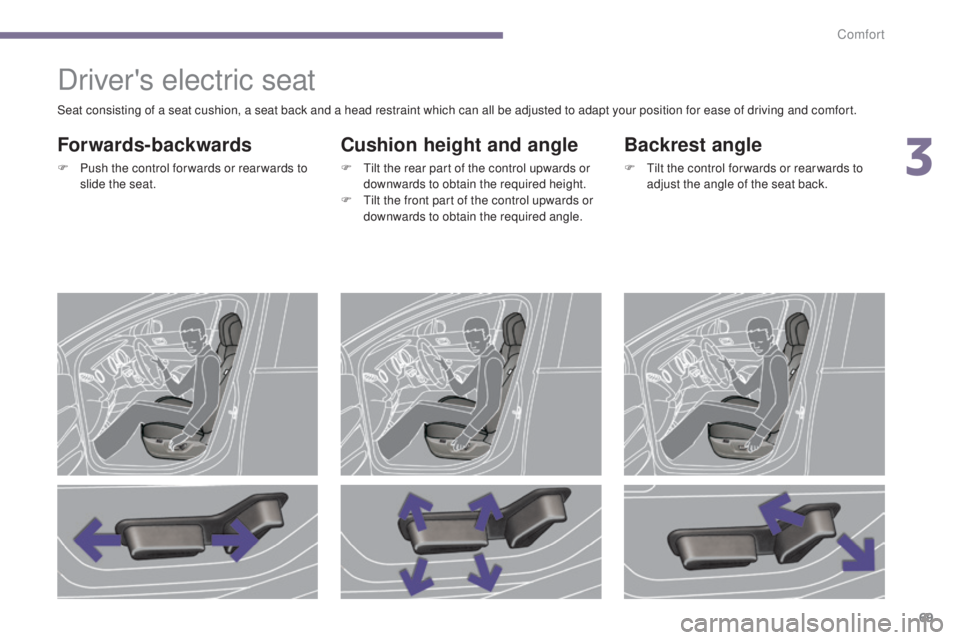
69
5008_en_Chap03_confort_ed01-2015
Driver's electric seat
Forwards-backwards
F Push the control for wards or rear wards to slide the seat.
Cushion height and angle
F Tilt the rear part of the control upwards or downwards to obtain the required height.
F
T
ilt the front part of the control upwards or
downwards to obtain the required angle.
Backrest angle
F Tilt the control for wards or rear wards to adjust the angle of the seat back.
Seat consisting of a seat cushion, a seat back and a head restraint which can all be adjusted to adapt your position for ease of driving and comfort.
3
Comfort
Page 72 of 364
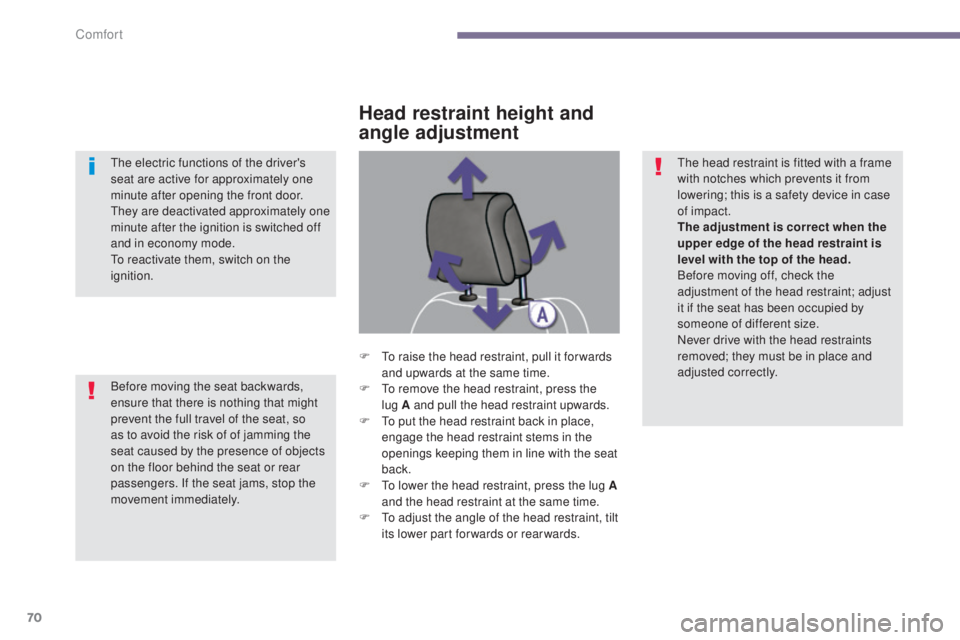
70
5008_en_Chap03_confort_ed01-2015
Before moving the seat backwards,
ensure that there is nothing that might
prevent the full travel of the seat, so
as to avoid the risk of of jamming the
seat caused by the presence of objects
on the floor behind the seat or rear
passengers. If the seat jams, stop the
movement immediately. The electric functions of the driver's
seat are active for approximately one
minute after opening the front door.
They are deactivated approximately one
minute after the ignition is switched off
and in economy mode.
To reactivate them, switch on the
ignition.F
T
o raise the head restraint, pull it for wards
and upwards at the same time.
F T o remove the head restraint, press the
lug A and pull the head restraint upwards.
F
T
o put the head restraint back in place,
engage the head restraint stems in the
openings keeping them in line with the seat
back.
F
T
o lower the head restraint, press the lug A
and the head restraint at the same time.
F
T
o adjust the angle of the head restraint, tilt
its lower part forwards or rearwards.
Head restraint height and
angle adjustment
The head restraint is fitted with a frame
with notches which prevents it from
lowering; this is a safety device in case
of impact.
The adjustment is correct when the
upper edge of the head restraint is
level with the top of the head.
Before moving off, check the
adjustment of the head restraint; adjust
it if the seat has been occupied by
someone of different size.
Never drive with the head restraints
removed; they must be in place and
adjusted correctly.
Comfort
Page 73 of 364
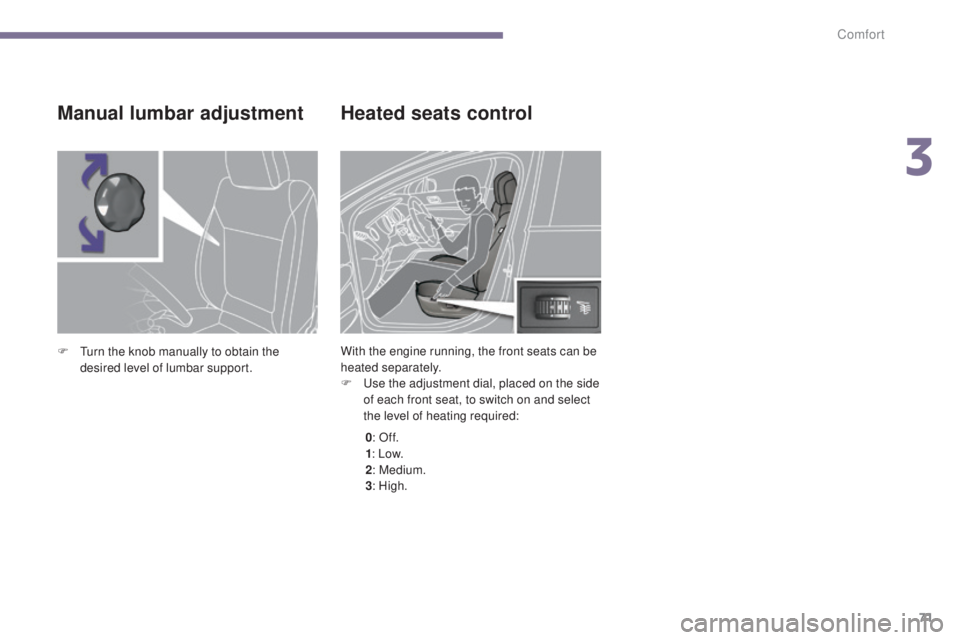
71
5008_en_Chap03_confort_ed01-2015
Heated seats control
With the engine running, the front seats can be
heated separately.
F
U
se the adjustment dial, placed on the side
of each front seat, to switch on and select
the level of heating required:
0 : Of f.
1 : Low.
2 : Medium.
3 : High.
Manual lumbar adjustment
F Turn the knob manually to obtain the
desired level of lumbar support.
3
Comfort
Page 74 of 364
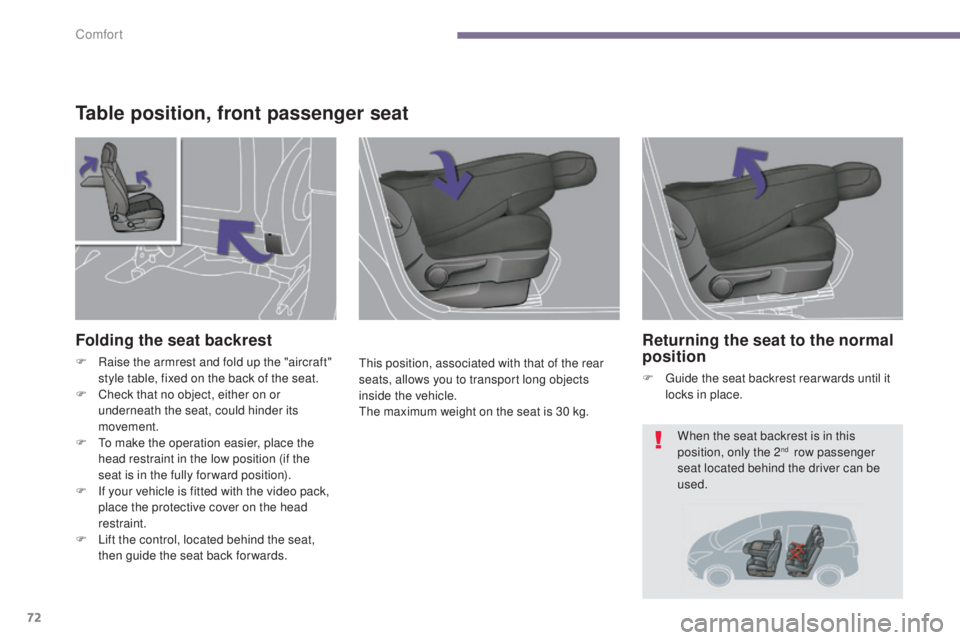
72
5008_en_Chap03_confort_ed01-2015
Table position, front passenger seat
This position, associated with that of the rear
seats, allows you to transport long objects
inside the vehicle.
The maximum weight on the seat is 30 kg.
Folding the seat backrest
F Raise the armrest and fold up the "aircraft" style table, fixed on the back of the seat.
F
C
heck that no object, either on or
underneath the seat, could hinder its
movement.
F
T
o make the operation easier, place the
head restraint in the low position (if the
seat is in the fully for ward position).
F
I
f your vehicle is fitted with the video pack,
place the protective cover on the head
restraint.
F
L
ift the control, located behind the seat,
then guide the seat back for wards.
Returning the seat to the normal
position
F Guide the seat backrest rear wards until it locks in place.
When the seat backrest is in this
position, only the 2
nd row passenger
seat located behind the driver can be
used.
Comfort
Page 75 of 364
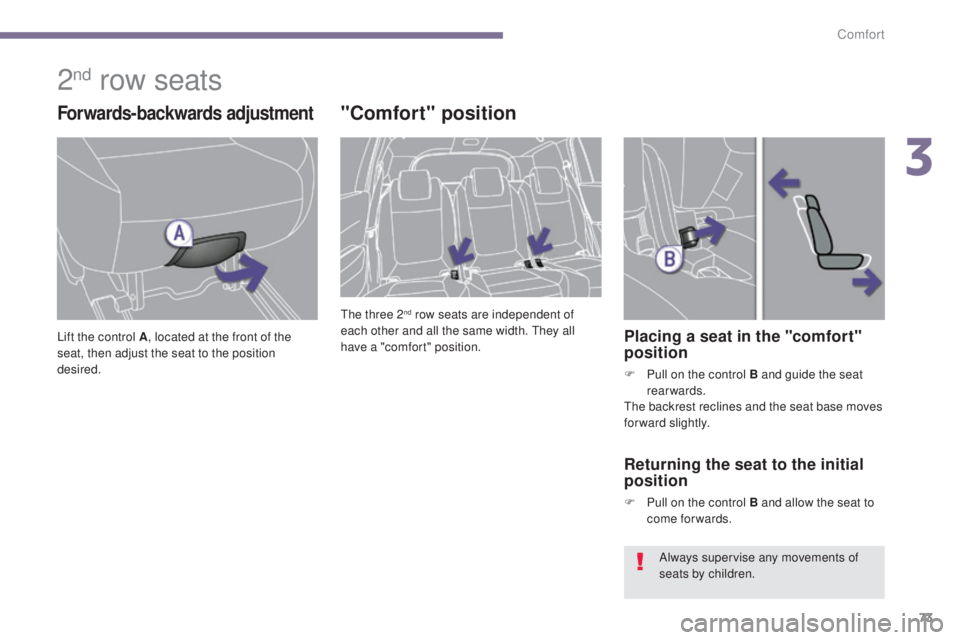
73
5008_en_Chap03_confort_ed01-2015
2nd row seats
Forwards-backwards adjustment
Lift the control A, located at the front of the
seat, then adjust the seat to the position
desired.
"Comfort" position
The three 2nd row seats are independent of
each other and all the same width. They all
have a "comfort" position.
Placing a seat in the "comfort"
position
F Pull on the control B and guide the seat rearwards.
The backrest reclines and the seat base moves
forward slightly.
Returning the seat to the initial
position
F Pull on the control B and allow the seat to come forwards.
Always supervise any movements of
seats by children.
3
Comfort
Page 76 of 364
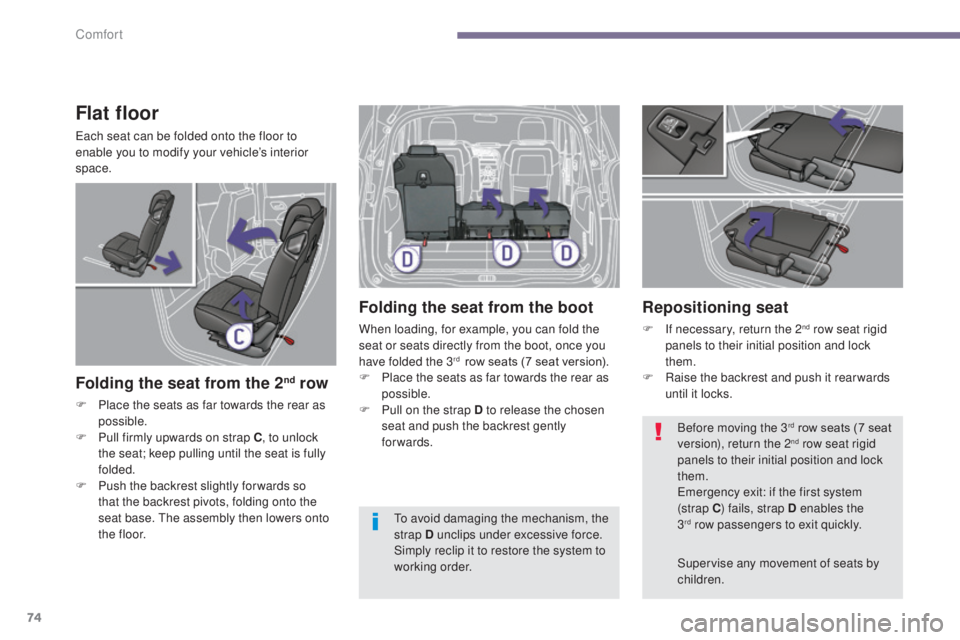
74
5008_en_Chap03_confort_ed01-2015
Flat floor
Each seat can be folded onto the floor to
enable you to modify your vehicle’s interior
space.
Folding the seat from the 2nd row
F Place the seats as far towards the rear as possible.
F
P
ull firmly upwards on strap C , to unlock
the seat; keep pulling until the seat is fully
folded.
F
P
ush the backrest slightly for wards so
that the backrest pivots, folding onto the
seat base. The assembly then lowers onto
t h e
f l o o r.
Folding the seat from the boot
When loading, for example, you can fold the
seat or seats directly from the boot, once you
have folded the 3
rd row seats (7 seat version).
F
P
lace the seats as far towards the rear as
possible.
F
P
ull on the strap D to release the chosen
seat and push the backrest gently
forwards.
Repositioning seat
F If necessary, return the 2nd row seat rigid
panels to their initial position and lock
them.
F
R
aise the backrest and push it rear wards
until it locks.
Supervise any movement of seats by
children. Before moving the 3
rd row seats (7 seat
version), return the 2nd row seat rigid
panels to their initial position and lock
them.
Emergency exit: if the first system
(strap C ) fails, strap D enables the
3
rd row passengers to exit quickly.
T
o avoid damaging the mechanism, the
strap D unclips under excessive force.
Simply reclip it to restore the system to
working order.
Comfort
Page 77 of 364
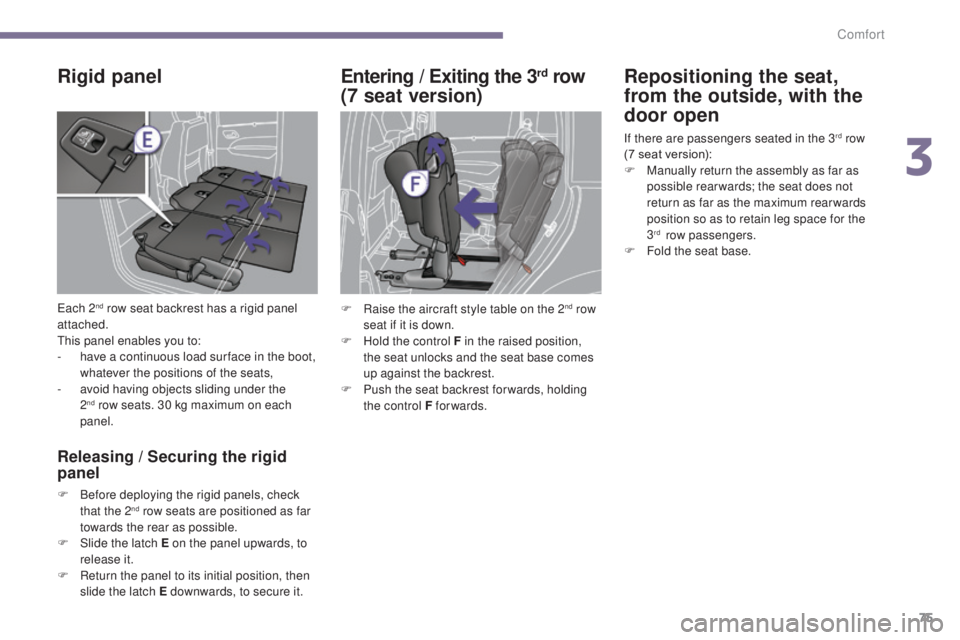
75
5008_en_Chap03_confort_ed01-2015
Rigid panel
Each 2nd row seat backrest has a rigid panel
attached.
This panel enables you to:
-
h
ave a continuous load sur face in the boot,
whatever the positions of the seats,
-
a
void having objects sliding under the
2
nd row seats. 30 kg maximum on each
pan el.
Releasing / Securing the rigid
panel
F Before deploying the rigid panels, check that the 2nd row seats are positioned as far
towards the rear as possible.
F
S
lide the latch E on the panel upwards, to
release it.
F
R
eturn the panel to its initial position, then
slide the latch E downwards, to secure it.
Entering / Exiting the 3rd row
(7 seat version) Repositioning the seat,
from the outside, with the
door open
If there are passengers seated in the 3rd row
(7 seat version):
F
M
anually return the assembly as far as
possible rear wards; the seat does not
return as far as the maximum rear wards
position so as to retain leg space for the
3
rd row passengers.
F
F
old the seat base.
F
R
aise the aircraft style table on the 2
nd row
seat if it is down.
F
H
old the control F in the raised position,
the seat unlocks and the seat base comes
up against the backrest.
F
P
ush the seat backrest for wards, holding
the control F forwards.
3
Comfort
Page 78 of 364
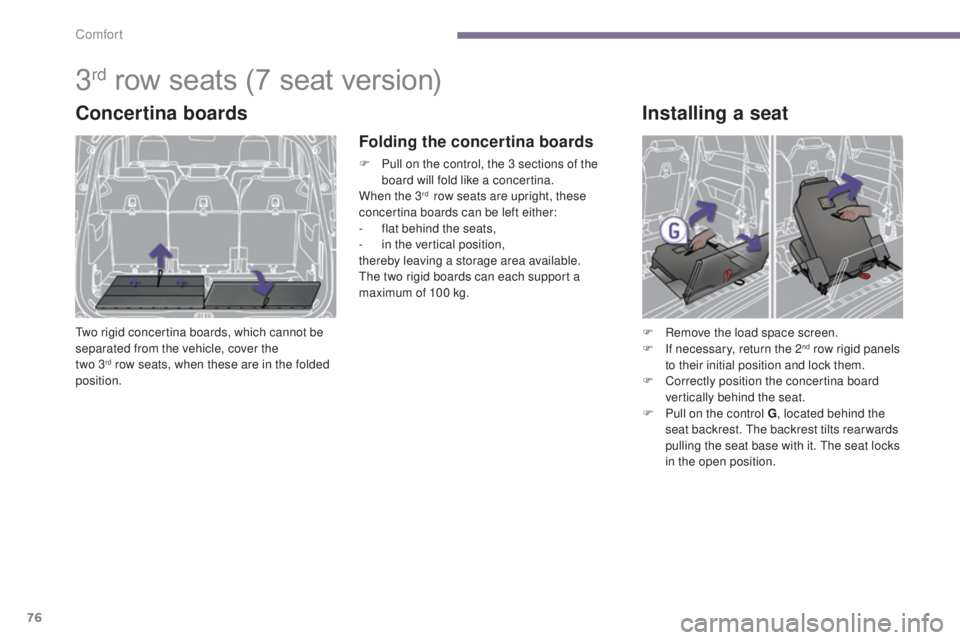
76
5008_en_Chap03_confort_ed01-2015
3rd row seats (7 seat version)
Concertina boards
Two rigid concertina boards, which cannot be
separated from the vehicle, cover the
two 3
rd row seats, when these are in the folded
position.
Folding the concertina boards
F Pull on the control, the 3 sections of the board will fold like a concertina.
When the 3
rd row seats are upright, these
concertina boards can be left either:
-
f
lat behind the seats,
-
i
n the vertical position,
thereby leaving a storage area available.
The two rigid boards can each support a
maximum of 100 kg.
Installing a seat
F Remove the load space screen.
F I f necessary, return the 2nd row rigid panels
to their initial position and lock them.
F
C
orrectly position the concertina board
vertically behind the seat.
F
P
ull on the control G , located behind the
seat backrest. The backrest tilts rear wards
pulling the seat base with it. The seat locks
in the open position.
Comfort
Page 79 of 364
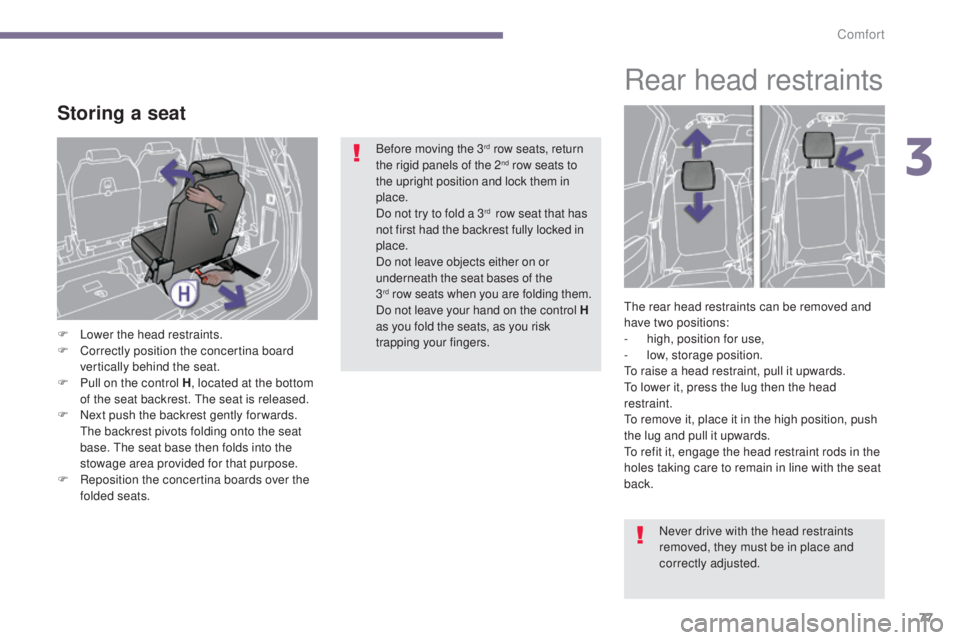
77
5008_en_Chap03_confort_ed01-2015
Storing a seat
F Lower the head restraints.
F C orrectly position the concertina board
vertically behind the seat.
F
P
ull on the control H , located at the bottom
of the seat backrest. The seat is released.
F
N
ext push the backrest gently for wards.
The backrest pivots folding onto the seat
base. The seat base then folds into the
stowage area provided for that purpose.
F
R
eposition the concertina boards over the
folded seats. Before moving the 3
rd row seats, return
the rigid panels of the 2nd row seats to
the upright position and lock them in
place.
Do not try to fold a 3
rd row seat that has
not first had the backrest fully locked in
place.
Do not leave objects either on or
underneath the seat bases of the
3
rd row seats when you are folding them.
Do not leave your hand on the control H
as you fold the seats, as you risk
trapping your fingers.
Rear head restraints
The rear head restraints can be removed and
have two positions:
-
h
igh, position for use,
-
lo
w, storage position.
To raise a head restraint, pull it upwards.
To lower it, press the lug then the head
restraint.
To remove it, place it in the high position, push
the lug and pull it upwards.
To refit it, engage the head restraint rods in the
holes taking care to remain in line with the seat
back.
Never drive with the head restraints
removed, they must be in place and
correctly adjusted.
3
Comfort
Page 80 of 364
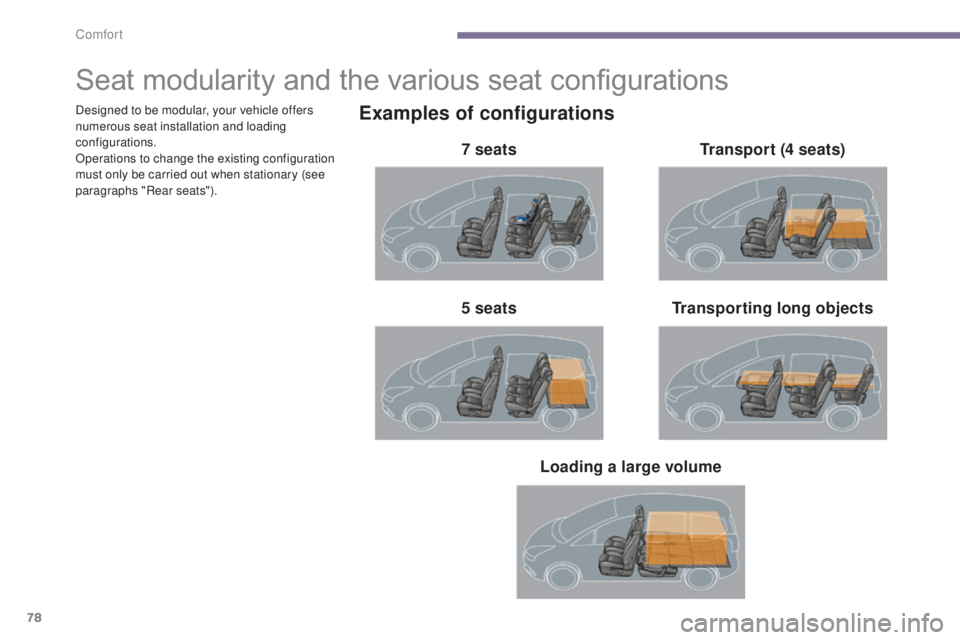
78
5008_en_Chap03_confort_ed01-2015
Seat modularity and the various seat configurations
Examples of configurations
7 seatsTransporting long objects
5 seats Transport (4 seats)
Loading a large volume
Designed to be modular, your vehicle offers
numerous seat installation and loading
configurations.
Operations to change the existing configuration
must only be carried out when stationary (see
paragraphs "Rear seats").
Comfort